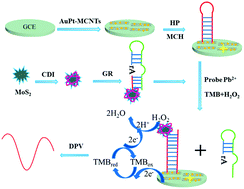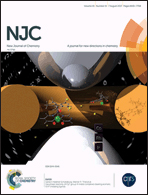A sensitive Pb2+ testing method based on aptamer-functionalized peroxidase-like 3D-flower MoS2 microspheres
Abstract
Herein, we proposed an electrochemical Pb2+ sensor using peroxidase-like GR aptamer-functionalized 3D-flower MoS2 microsphere (MoS2–GR) hybrids as signal probes. AuPt nanoparticles and multiwalled carbon nanotube composites (AuPt–MCNTs) were successively modified on a glassy carbon electrode (GCE), which improved the electronic transfer rate as well as increased the amount of immobilized capture hairpin DNA (HP). In the presence of Pb2+, GR could be specifically cleaved at the ribonucleotide (rA) site, which produced the short MoS2–GR to hybridize with HP immobilized on the surface of the GCE. Because of the mimic peroxidase property of MoS2, an enzymatically amplified electrochemical signal was obtained to achieve the sensitive detection of Pb2+. In addition, benefiting from the Pb2+-dependent GR, the proposed assay could selectively detect Pb2+ in the presence of other metal ions. This method showed a good linear relationship between the current response and the Pb2+ concentration ranging from 0.03 to 500 nmol L−1 with a detection limit of 0.015 nmol L−1. The new, robust, and convenient assay systems can be widely utilized for the identification of other target molecules.



 Please wait while we load your content...
Please wait while we load your content...